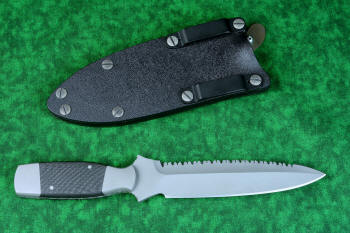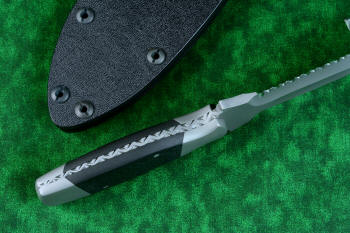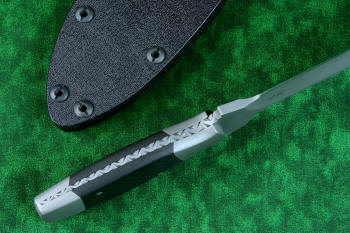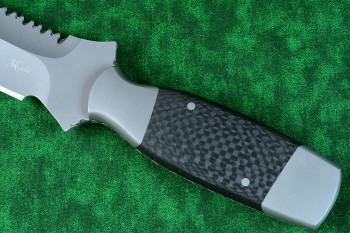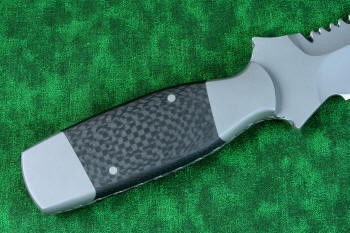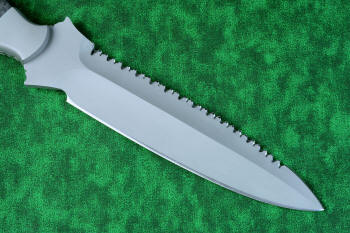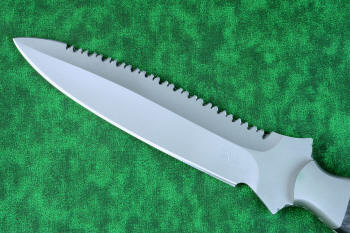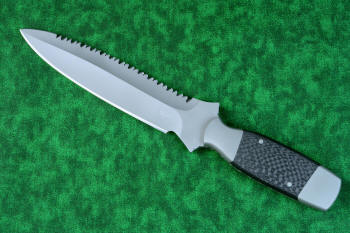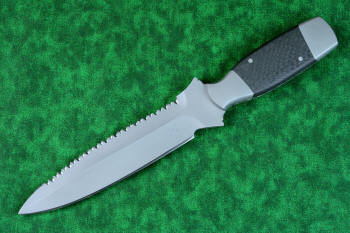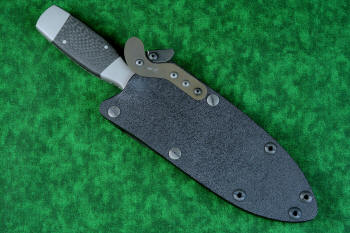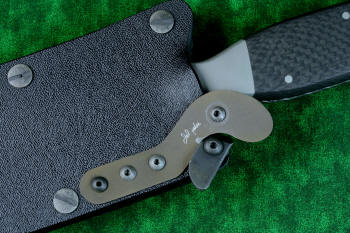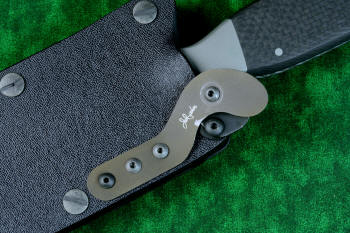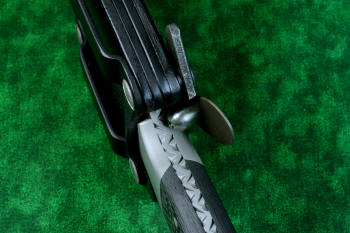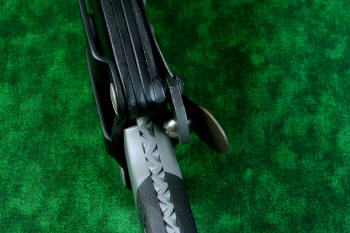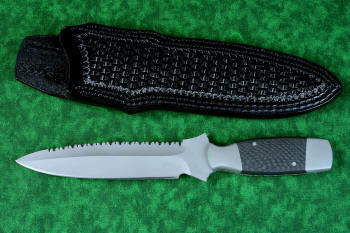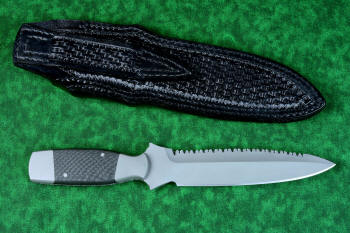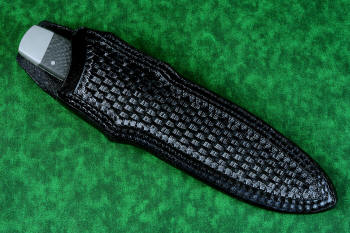Lynx Custom Knife
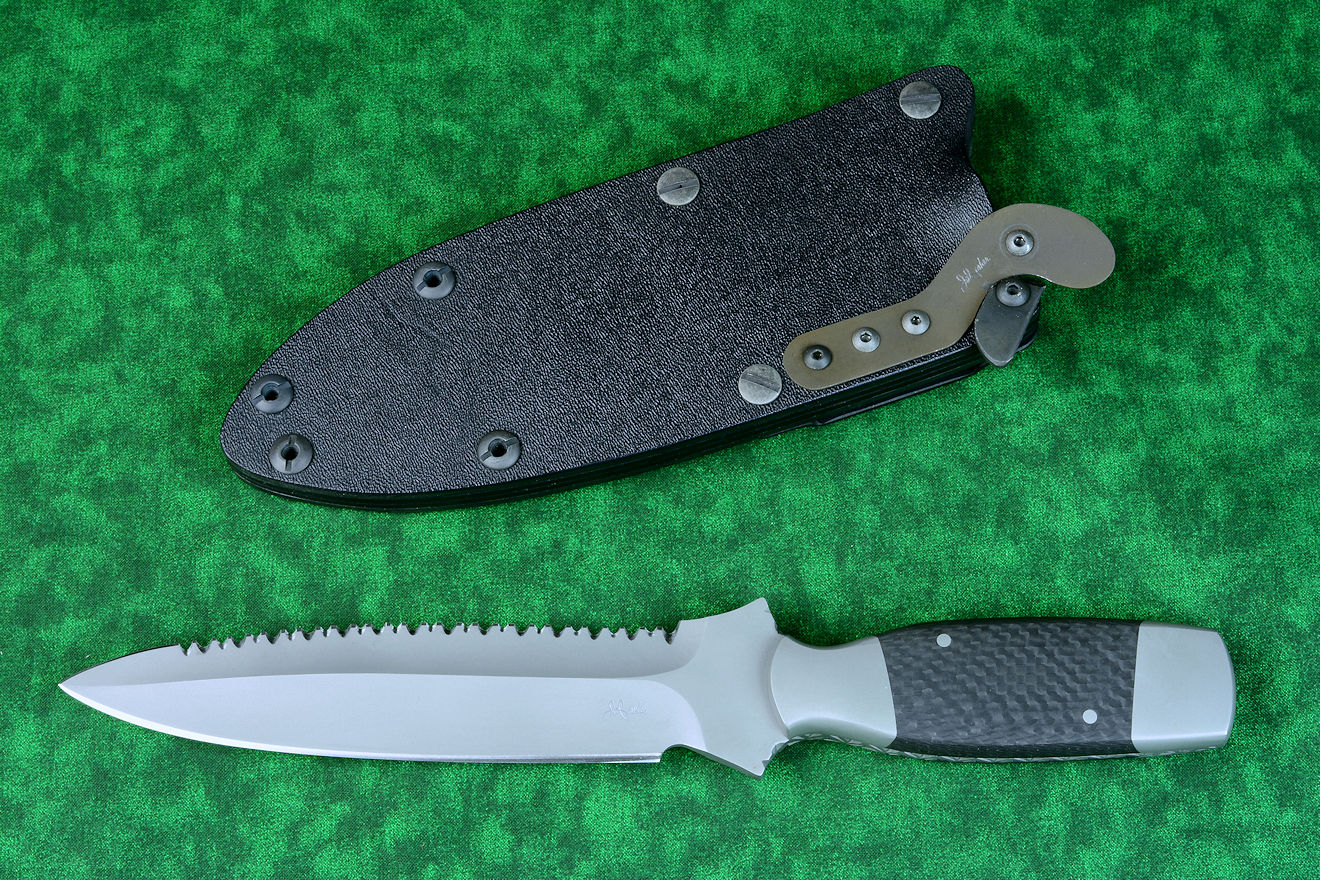
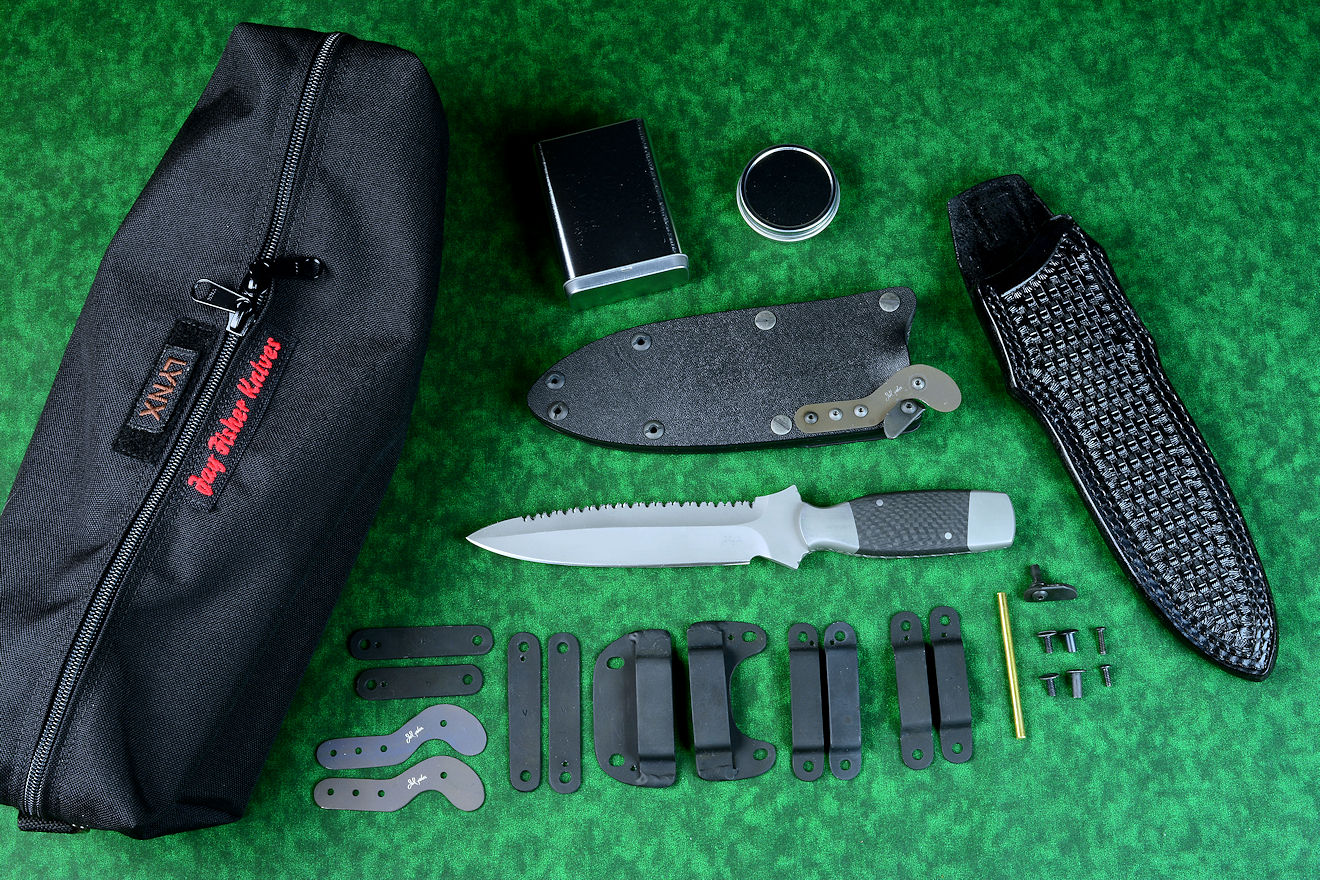
"Lynx" Custom Professional Tactical,
Counterterrorism Knife
- Size: Length overall: 10.8" (27.4 cm), Blade Length: 6.0" (15.2 cm), Thickness: 0.211" (5.4 mm)
- Weight: Knife: 10.5 oz. (298 grams) Sheath HTL-TW: 9.5 oz. (269 grams), Leather: 6.0 oz. (170 grams)
- Blade: ATS-34 high molybdenum martensitic stainless steel blade, T3 deep cryogenically treated with triple tempering to 59.5 HRC, media blasted flat
- Sheath: Tab-wedge hybrid tension in kydex, anodized 5052H32 aluminum, blackened 304 stainless steel, anodized 6AL4V titanium
- Sheath: Hand-stamped black basketweave 9-10 oz. leather shoulder
- Hardware, Fasteners: 304 stainless steel, darkened, 6AL4V anodized titanium, 5052 H32 high strength aluminum alloy, anodized
- Duffle: 1000 Denier Cordura Ballistic Nylon, polypropylene, polyester, nylon, blued steel, embroidered tags
- Knife: Made for a great client to his
specifications, this is my Lynx tactical dagger. This is a great
knife, stout and compact, slender and serious, what we call in the
field a "fast" knife. This is due to its compact size and light
weight, and ability to be brought into action quickly and smoothly.
I named this design the Lynx because of the dangerous speed and
claws of the animal.
- The Steel I chose for the Lynx
blade is ATS-34, a high
molybdenum martensitic stainless steel. The molybdenum aids in
forming nucleation sites for complex carbide development,
and when properly treated, increases the toughness dramatically,
resulting in a blade that's extremely durable. This allows
me to temper the steel at a higher overall hardness
(59.5 HRC), producing a rigid blade. This also means
great wear resistance and less sharpening throughout the
life of the knife. The high chromium and high
carbon results in profuse chromium carbides, increasing
corrosion resistance as well as wear resistance. To bring
this steel to its zenith, I used my proprietary T3 deep
cryogenic process in heat treating this blade; it's a highly
detailed, extremely sophisticated process that takes 33
individual steps and takes over a week long. The result of this is an
incredibly wear-resistant blade that has extremely high carbide
development, fine grain, and extremely high toughness. Asperity is
reduced; the microstructure development is superior to any other
typical handmade knife, and far above any factory or
manufactured knife. This is, simply put, ATS-34 at its very finest
advanced condition.
- The Blade is a special shape, it's a
tightly hollow ground dagger, what might be called a "spear"
because the blade profiles are almost identical. It's the
difference that matters, and the central spine apex is
offset. This is called a "differential" grind. The main blade is razor keen and even, and is ground
with an 8" contact wheel for a broader hollow grind, and
thinner cutting edge. The top edge is hollow ground with a
3" contact wheel, for a tight radius, and high strength, and
has my "microblade" serrations. These are small, extremely
sharp blades spaced between alternating deeper scalloped
cuts. These serrations are surprisingly aggressive, and not
prone to hanging up or snagging. The blade has large
quillons to protect the hand from sliding forward onto the
edges. The dominant factor of this knife is the offset thick
spine, with substantial strength all the way to the piercing
tip. There is no flex in this blade.
- The knife feels like a solid mass in
the hand, yet the blade seems light and formidable. The
balance point is exactly at the forefinger grooves.
- The handle is all business, it's built on at tapered
tang that has substantial thickness at the butt. The tang is
fully fileworked with an aggressive "thorny vine" pattern
for increased purchase and handmade distinction. The knife
is bolstered with 304 high chromium, high nickel austenitic
stainless steel bolsters for zero care, and they are
dovetailed to bed a pair of very technical, high strength
carbon fiber scales. The curve of the handle is just right;
it is swallowed in the hand and feels solid and secure. The
entire handle, like the blade, is media blasted for a flat,
non-reflective finish.
- Sheath: NEW! The sheath is an advanced evolution of my hybrid tension-locking sheath, a wedge-opening model.
- Materials: It's built on a frame
of 5052 H32 corrosion-resistant high strength aluminum alloy welts.
The individual welts are then anodized for a full mil of thickness,
twice the thickness of typical anodizing. The anodizing creates a
built-up near-ceramic hard surface on the aluminum, and it's
entirely corrosion-resistant and non-conductive. It's permanently
dyed (in black) and sealed with a solution that inhibits ultraviolet
degradation of the dye and anodized surface. In fact, all of the
aluminum components in this assembly are the same alloy
and are treated this way; this is
the most advanced condition that will even withstand marine use. The sheath front and
back are double-thickness kydex, twice the thickness of typical
knife sheaths, and the sheath is bonded with waterproof marine-grade
cement and secured with darkened 304 stainless steel
Chicago screws.
- Layout: As with all of my sheaths, they are built on a 2.5"
center hole pattern, so the components can be moved around an
mounted in various positions on the sheath. As with all
of my tactical sheaths, this one is completely reversible
for as many wear options as possible. Most of my accessories can be used on this
sheath, including any new ones I develop.
- Horizontal Belt Loop Plates for horizontal belt or webbing wear,
welded for ultimate strength and light weight,
reversible, and in black anodized aluminum.
- Flat mounting straps for rigid clamping to
webbing, belts, or gear in vertical or horizontal
orientation in black anodized aluminum.
- Low profile belt loops
(footman's loops): for tactical webbing belts with
maximum .190" thickness and 1.5" width in black
anodized aluminum
- High profile belt loops
(footman's loops): for tactical webbing belts with
maximum .250" thickness and 1.5" width in
black anodized aluminum
- High profile wide belt loops
(footman's loops): for tactical webbing
belts with maximum ..250" thickness and 1.75" width
in black anodized aluminum
- All necessary stainless steel hardware, fittings, fasteners and tools for mounting, moving, and adjusting
- Tab-Wedge (TW) Release: An advanced feature of
this knife sheath is the security and retention
mechanism. I've used my standard hybrid tension lock, so the knife
can be retained with the pressure of an anodized 6AL4V titanium
dog-leg spring, and I've included three of those so the
user can choose which strength to apply. In an
emergency, the ball and spring can be deflected with a hard
tug, and I wanted to leave that choice to my client if he
wished for a standard setup. However, because of the proximity of the
serrations to the ball-lock, I've created the tab-wedge (TW)
release to allow the ball to clear the knife blade area
completely, with the pressure of the thumb. This also makes
sheathing and unsheathing a one-hand certain operation.
Here's how it works: when sheathed, the tension-lock
mechanism works as normal. The knife is retained in the
sheath by the pressure of the ball delivered through the
titanium spring, against the inside curve of the bolster.
When the user needs the knife, he simply pulls the tab
toward his hand with his thumb, and the wedge lifts the titanium spring and ball
away from the knife, clearing the blade, the serrations, and leaving
the entire mouth of the sheath open. Then, the knife is unsheathed.
It takes much more effort to describe it than to use it; the motion
is natural with the thumb. You wrap your hand around the handle,
pull-flip the tab-wedge, and extract the knife. Reinsertion
is just as simple; you slip the knife in the sheath (as the ball and
is completely out of the way) and then use the thumb to
push-swivel the tab forward, closing the ball on the thumb rise, and locking the
knife in the sheath. Because I've built these sheaths to be
completely reversible, I've included two tab-wedges, one for
each side. If my client wants to forego the locking-tab-wedge
entirely, he simply replaces the post mounted to the rotating tab
with a standard Chicago screw post, and he then has the typical
hybrid tension-lock. However in this design of knife,
the serrations may contact the ball and this will not be a
good outcome. It won't hurt the blade, but the ball will be
damaged. In an emergency, the owner probably won't mind, as
he needs his knife immediately, so I left that option. Improving this design is representative to
my commitment to excellence in service to the people who
purchase and depend on these knives, and it's an honor to design
these for the hardest of environments and use.
- Sheath: Black basketweave leather is a classic,
and this is a special one. Because this knife is double-edged and
frankly, dangerous to contact at the blade, I've designed and made
an extremely deep and protective leather sheath, hand-stamped
basketweave pattern, double row stitched it throughout with
polyester high strength thread, dyed it black, and finished it with
lacquer. This is a tight, deep sheath, not one the knife will easily
be removed from, for a reason. That reason is that the protection of
the wearer is the first concern in the building of a knife sheath, so it's built
around substantial welts and made of 9-10 oz. thick leather
shoulder. It takes a manly hand to unsheathe the Lynx, and that is
how it should be on this type of knife. Even the belt loop is tough and double-row
stitched for strength.
- Containers, Instructions, Archival: included are tin plated
steel containers for the fasteners and hardware, and the
instructions for the rig including a checklist for the
kit. Included is an engraved co-extruded acrylic archival plate.
- Mini-Duffle: One thing I found out over the
years was a need to store these components that was as tough and
durable as what they contained. This is why I make the duffles, in
my studio, by hand. I make them in 1000 Denier Cordura ballistic
nylon, which is coated on the inside with polyurethane for moisture
resistance. This is some very tough stuff, and I triple-stitch the
seams, all in heavy polyester thread. I've included steel D-rings at
the zipper stops on the ends for several reasons: to mount accessory
straps or carry options, to clip accessories, and to oppose the
zipper when pulling open. Otherwise, you have to pinch the material
to open the zippers with one hand and pull the zipper pull with the
other. I've used double zipper pulls.
The design of the duffle is a box-end, so that the duffle stores
neatly, and it's not too big but accommodates the kit well, with
some room to spare. It has my "Jay Fisher Knives" embroidery, and opposing that is a hook and
loop stitched tag mount, with a removable embroidered identifier of
the knife pattern. This is important when clients have more than one
knife. These duffles are so great, I have clients buying them
alone without a knife, for their friends and other stowed gear!
- The Lynx is a great custom tactical and counterterrorism knife,
complete with professional gear.
Thanks, P. K.!
They arrived today. I expect perfection and you delivered as always.
The kits were a surprise to me. I know this sounds stupid to you, but, I am so use to
a masterpiece and a sheath to be put on display. The embellishments, on the weapons, cause
one to look at them as art pieces and not weapons of war. The kits bring home the seriousness
of your works and the need for full kits. In the future I will get full kits.
I would guess the majority of patrons do not truly understand what you do. The trolls and detractors
miss the mark completely. Your creations mean the difference between life and death.
Yours Truly:
P.
Please click on thumbnail knife photos
